One of the advantages of the E-mount is its ability to accept, with the proper adapter, lenses from many other mounts. The short register (flange) distance and moderate diameter of the E-mount means it is theoretically compatible with a large number of DSLR mounts.
One such mount is the Pentax K-mount. Originally created in 1975, the mount of course evolved over time, but contrary to most other camera manufacturers who broke compatibility at some point in time, Pentax added to the mount while always preserving backwards compatibility. Over the years, there have been million of K-mount lenses made, some of which are jewels worthy of interest.

Adapting K-mount lenses to Sony’s E-mount has been possible almost since the latter’s inception, but with the caveat that adapted lenses would be manual focus, with manual control over the aperture. This changed in 2020 with the launch of the Monster Adapter LA-KE1. Proposed by a small Chinese company, this adapter is the first (and currently sole) adapter offering native autofocus for Pentax K-mount lenses on E-mount bodies. This adapter is of great interest for Sony users wishing to use Pentax glass and for Pentax users who are also interested in Sony’s excellent AF and in using an EVF.
The product has seen three important firmware versions since launch. v01 only supported screw-drive lenses. v02 added support for in-lens motors. The third update v03, freshly released in January 2023, greatly expanded the number of supported lenses, added some teleconverters, and improved AF speed and accuracy on specific camera bodies. The company now claims their AF can be faster than Pentax’s.
In this review we put the Monster Adapter through its paces to determine whether or not it is a useful and relevant product for photographers interested in using Pentax lenses on Sony bodies.
Table of Contents[Hide][Show]
A Brief Introduction to Pentax Lenses
Before looking in detail at the LA-KE1 adapter, a quick introduction of Pentax lenses terminology is in order.
The K-mount includes several generations:
- K lenses: these lenses are the first bayonet lenses from the company, and bear an aperture ring. They are fully manual and started in 1975. Mostly primes, some are still well liked.
- M lenses: similar to K lenses, they are more compact and generally use better coatings. They were introduced in 1981. There are some unique pieces in this line.
- A lenses: the aperture ring now includes an A position and the lenses support auto exposure. Focus remains manual. They launched in 1983. Optically mostly similar to M lenses.
- F lenses: the first line of autofocus lenses from Pentax, launched in 1989. Primes are still well-regarded today.
- FA lenses: second generation of AF lenses, launched in 1991, this time with deeper communication with the camera (including lens performances characteristics). Two power zoom / electronic contacts were added. Primes and some zooms are excellent.
- DA lenses: introduced in 2004, first line designed specifically for digital. APS-C only, most lenses lack an aperture ring. Lenses can use screw-drive, or one of the various in-lens motor options.
- D FA lenses: similar to DA, but with a diameter adapted for full frame.
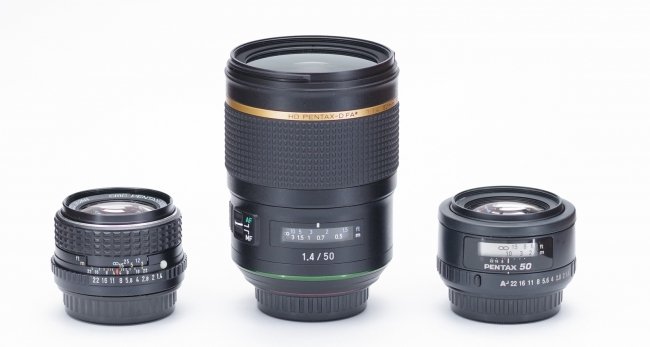
Pentax lenses can bear either the SMC (Super Multi Coated) of HD (High Definition) label. Both refer to evolving coatings technologies, a domain where Pentax has long been a leader. HD is more recent, and even higher-performance, than SMC, leading to better flare and CA control.
In-lens AF motors come in three flavours, available on DA and D FA lenses:
- SDM: Supersonic Direct-drive Motor. First generation, quiet if not silent, not particularly fast in most cases (recent lenses are much better). Some lenses have a less than stellar reputation for SDM reliability.
- DC: Direct Current. Generally very fast and reliable. Nearly silent.
- PLM: Pulse Line Motor. Completely silent, very fast AF, available on smaller lenses with low weight.
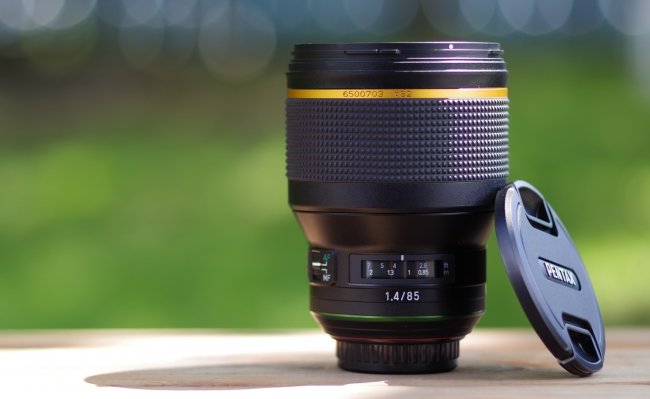
There are two particular lens labels worthy of attention:
- Limited: these are FA and DA lenses, primes except for one exception. Beautifully crafted with metal bodies, they are designed to be compact, large aperture, meant to deliver images with unique character and a signature look. They are optically excellent but really emphasize rendering. Some Pentax users pretend these lenses are made with pixie dust and are probably among the most interesting to be adapted on Sony bodies.
- STAR: this is the pro line from Pentax. These lenses bear an actual star in their name. Primes and zooms have fast apertures. These lenses are weather resistant, no-compromise in their optical design, generally close to being best-in-class. Most are DA* and D FA*, but there were F* and FA* lenses made.
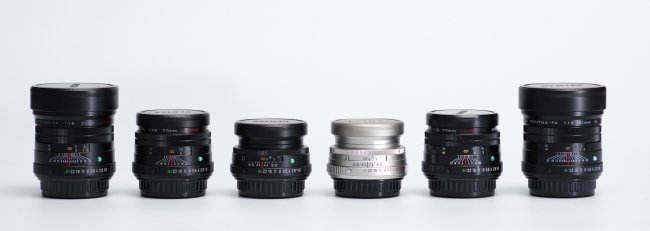
WR and AW labels denote lenses with weather resistance. AW (All Weather) is even more reliable than WR (Weather Resistant).
Monster Adapter Specifications
Who Is It For?
This is one of the main questions which needs to be answered: who should care about this adapter? After all, Sony already has a nicely fleshed-out lens lineup, so why look at Pentax lenses?
One potential user base is made of Pentax users also interested in tipping their foot into the mirrorless world, without leaving the K-mount behind. Using the Monster Adapter minimizes the cost of testing the Sony system.
Another group is made of current Sony users, either curious about Pentax lenses (some of which having near-cult status) or wanting to fill holes in the Sony offerings.
Indeed, Pentax has some pretty unique lenses to offer. Chief among those are probably the three FA Limited. Nicknamed the Three Princesses, the 31mm F1.8, 43mm F1.9 and 77mm F1.8 are known for their small size, beautiful craftsmanship and unique rendering. The odd focal lengths and apertures allowed the designer (now working at Tamron, and a legend in Japan) to tune his designs finely instead of being constrained by typical focal lengths (the lenses would be equivalent to 28mm, 50mm and 85mm). A D FA 21mm F2.4 Limited was recently added to this group, offering AW, DC AF and the same unique rendering.

To compare, the FA 77mm F1.8 Limited is the same size as Sony’s FE 28-60mm retractable lens, when retracted! The FA 43mm F1.8 is a true pancake lens, smaller than Sony’s FE 40mm F2.5 G even including the Monster Adapter. The FA 77mm, priced at around $625 USD, can probably be best compared with Zeiss’ Batis 85mm F1.8, which costs over a thousand dollars more.
Other lenses can also be of interest. APS-C primes are few on the E-mount, while Pentax offers many, including 5 DA Limited and many compact options. Most Sony full frame zooms are rather large, and there is a gap for primes between 135mm and 400mm. As such, Pentax FA/DA* 200mm F2.8 and FA/DA* 300mm F4 primes can be of interest, as can be the several compact Pentax full frame zooms.
Modern lenses (from all manufacturers, not just Sony) often rely heavily on in-camera corrections. Older designs, especially those created for film cameras, can’t benefit from today’s software improvements, and had to be as good as possible right from the start. This can be beneficial in some cases, particularly for users shooting RAW.
The groups mentioned above can all benefit from the Monster Adapter LA-KE1. Still, it is likely that the largest audience for the adapter will be made of enthusiasts who simply love to experiment, discover, challenge their photography. These users will get a richer experience with a fully automated Adapter than with a manual one.
Construction And Handling
The Monster Adapter LA-KE1 feels like a quality product, with a metal housing, robust feel and small size. It feels premium despite being made from a lesser-known manufacturer.
Body

The adapter’s body is almost entirely metal. It has a mostly circular shape, with two bumps.
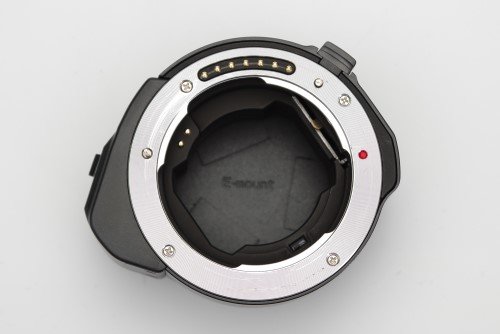
Seen from the top, there is a small bump to the right, and a bigger one to the left.

The left bump holds a button to switch from AF to MF, a welcome feature lacking on some Sony bodies. The company and model labels are printed to the front.

To the right is the K-mount release lever. It works as expected.
The adapter does not change its shape in operation. There are no moving parts.

The LA-KE1 offers a full K-mount interface. This means it has a screw-drive motor built-in, as well as contacts for in-lens motors and a series of contact points for aperture communication.
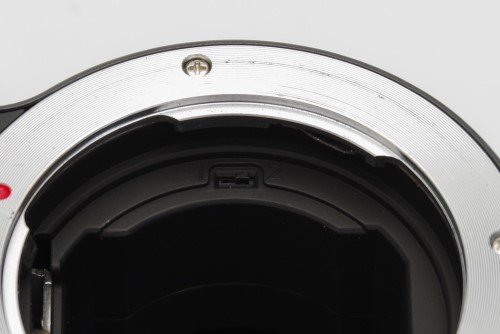
Inside the adapter is a small lever, easy to miss. It offers something no Pentax camera proposes: the ability to switch between SDM and screw-drive. Some of the first SDM lenses proposed by Pentax feature both types of AF motors, to allow backwards compatibility with older bodies not supporting SDM. In some rare (but highly publicized) cases, those lenses suffered from faulty SDM motors which started behaving poorly after a few years. The LA-KE1 can thus serve to revive a lens by forcing it to use screw-drive AF.
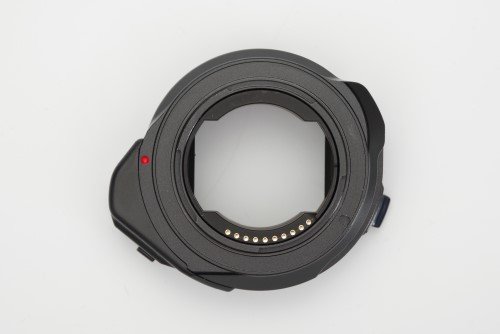
To the rear, an E-mount alignment dot is visible on the black surface. Note that with the silver front and the black rear, it is easy to see which side is which. There is no weather protection on the adapter, sadly.
Size
The adapter must respect the flange distance between K-mount and E-mount, so its size is similar to other “dumb” adapters. Below are images of lenses mounted.
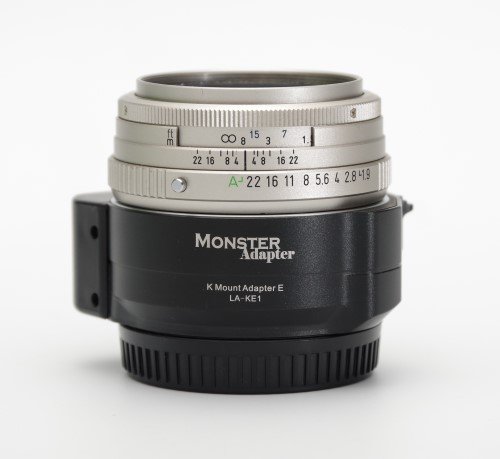

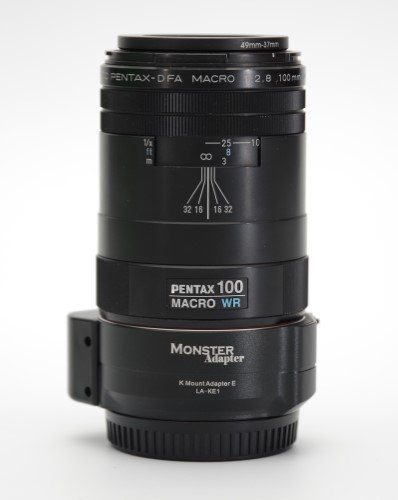
These next images show some Pentax lenses on the Monster Adapter, next to E-mount lenses.
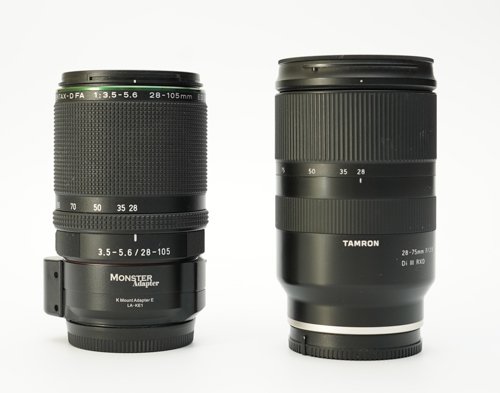


Mounted On Camera
Below are images of the adapter mounted on the Sony a7C, with the FA 43mm F1.9 Limited and D FA 100mm F2.8 Macro WR.
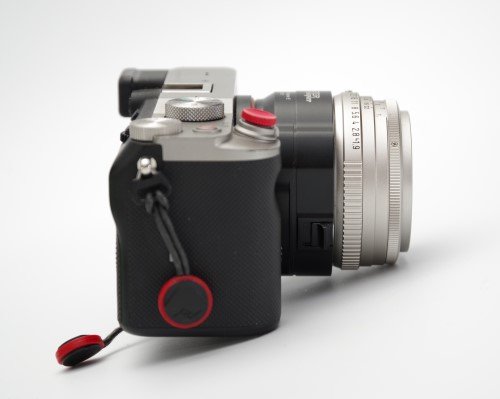
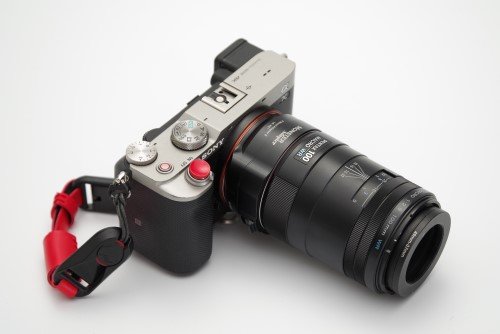
In the Hand
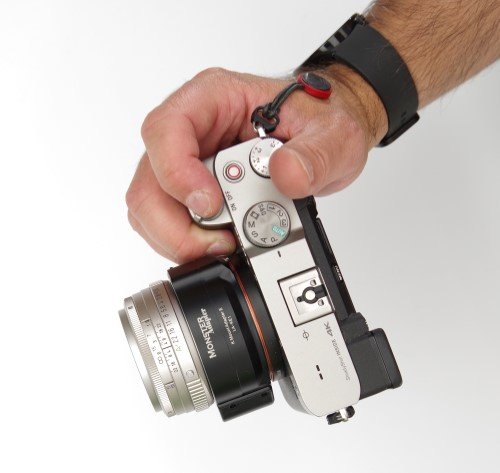
In use, the adapter feels reliable and functional. The AF/MF switch gives good feedback and clicks nicely. Contrary to a typical lens, the Monster Adapter LA-KE1 has an irregular shape with bumps on the sides. Because of this and of the position of the bump closest to the camera grip, space can become tight for users with larger fingers. In use, we have not found space to be too tight when holding the camera, but we did squeeze our middle finger once or twice when removing the adapter. This will vary with finger sizes, camera grip format and the way the user holds the camera, but is something to be aware of.
Lens And Camera Compatibility
The LA-KE1 is a full autofocus and auto-exposure adapter. In other words, it acts as a translator between the camera and lens, which do not communicate with the same protocols. Therefore, it needs to be optimized for specific bodies and lenses.
The adapter will physically work with any lens, even purely manual ones. In that case however, it will act as a “dumb” adapter, simply providing physical contacts. Focus will be manual. Thankfully, nearly all of the K-mount lenses ever made use mechanical focus gears instead of focus-by-wire, so manual focus is possible at all times. When using a compatible lens on a designated body, the adapter provides full compatibility. From a user’s perspective, it will be identical to mounting a native E-mount lens. Specifically, the adapter allows:
- Autofocus (both AF-S and AF-C)
- Auto exposure
- Full EXIF information transfer
- Eye focusing (human and animal)
- AF-C speeds matching high-speed burst rates (10 or 30 fps)
- Full field of view AF coverage
- Use the camera’s image stabilization (K-mount lenses do not include in-lens stabilization)
- Firmware updates via the camera
Again, we must stress that the adapter allows operation for stills shooting, not movies. It will work in movie mode but most features will be disabled. This is caused by how Sony cameras work with adapters and is a limitation of the system.
EXIF Information
The adapter allows the camera to record full EXIF data into the image file. There is one caveat: the camera doesn’t know the actual lens name, so it uses a generic equivalent, as illustrated by the screenshot below, for a picture captured with the SMC Pentax D FA 100mm macro WR:

Firmware Versions
The adapter first shipped with v01, including a limited number of lenses. The company quickly released v02, adding numerous lenses to the list of supported products.
On January 1st, 2023, Monster Adapter released their most important update yet. v03 includes even more lenses, but more importantly now provides access to their “G Driver version 2” algorithm. This algorithm is supposed to provide better AF performances with screw-drive lenses. It will be discussed in more details in the Autofocus section.
Lens Compatibility
As mentioned before, the LA-KE1 adapter is not compatible with all lenses and camera bodies. Monster Adapter keeps an up-to-date list of compatible cameras and lenses on their website.
This limitation comes from the differences between the Sony and Pentax AF systems. Sony cameras expect some information not supplied by Pentax lenses. This information must be supplied by the adapter instead. As such, Monster Adapter needs to specifically collect and include the information for each lens individually into their firmware.
Lenses not listed as supported, but including electronic contacts (A, F, FA, DA, D FA lenses) could work with some limitations, but could also cause unexpected behaviors and even maybe cause damage to the system. It is not recommended to risk it. An unsupported lens should be used with a dumb adapter. Lenses without an aperture ring will be hindered by this, but most of those are supported by the LA-KE1.
For lenses to operate in AF mode, the aperture ring (when the lens has one) must be set to the A position.
Supported lenses (as of firmware v03) are listed below. A total of 64 lenses and teleconverters are currently supported.
Prime Lenses
SMC F Lenses
- SMC F 28mm F2.8
- SMC F 50mm F1.4
- SMC F Macro 50mm F2.8
- SMC F Macro 100mm F2.8
SMC FA / D FA Lenses
- SMC FA* 24mm F2 AL
- SMC FA 28mm F2.8
- SMC FA 28mm F2.8 SOFT
- SMC FA 31mm F1.8 Limited
- SMC FA 35mm F2
- Samsung/Schneider D-XENOGON 35mm F2
- SMC FA 43mm F1.9 Limited
- SMC FA 50mm F1.4
- SMC FA Macro 50mm F2.8
- SMC D FA Macro 50mm F2.8
- SMC FA 77mm F1.8 Limited
- SMC FA* 85mm F1.4
- SMC FA 85mm F2.8 SOFT
- SMC D FA Macro 100mm F2.8 WR
- Samsung/Schneider D-XENON 100mm F2.8 Macro
- SMC FA 135mm F2.8
- SMC FA* 200mm F2.8
- SMC FA* 300mm F2.8
- SMC FA* 300mm F4.5
- SMC FA* 400mm F5.6
SMC DA Lenses
- SMC DA 14mm F2.8
- SMC DA 15mm F4 Limited
- SMC DA 21mm F3.2 Limited
- SMC DA 35mm F2.4
- SMC DA 35mm F2.8 Macro Limited
- SMC DA 40mm F2.8 Limited
- SMC DA 40mm F2.8 XS
- SMC DA 50mm F1.8
- SMC DA* 55mm F1.4 SDM
- SMC DA 70mm F2.4 Limited
- SMC DA* 200mm F2.8 SDM
- SMC DA* 300mm F4 SDM
HD DA Lenses
- HD DA 15mm F4 Limited
- HD DA 21mm F3.2 Limited
- HD DA 35mm F2.8 Macro Limited
- HD DA 40mm F2.8 Limited
- HD DA 70mm F2.4 Limited
HD FA / D FA Lenses
- HD D FA 21mm F2.4 Limited DC WR
- HD FA 31mm F1.8 Limited
- HD FA 35mm F2
- HD FA 43mm F1.9 Limited
- HD D FA* 50mm F1.4 SDM AW
- HD FA 77mm F1.8 Limited
- HD D FA* 85mm F1.4 SDM AW
- HD D FA Macro 100mm F2.8 WR
“SOFT” lenses allow AF and aperture adjustments only when the aperture ring is set between f4.5-f32. The camera’s aperture setting must match the one on the lens to avoid exposure errors. As such, these lenses are not auto-exposure with the LA-KE1. AF accuracy with the FA 28mm SOFT cannot be guaranteed.
Samsung-branded lenses are full rebadges of Pentax products.
This list is impressive to say the least. It even includes lenses from the 80’s, dating from the early days of Pentax’s AF lenses. Most modern lenses are supported. Missing elements mostly come from the F line (the SMC F 50mm F1.7 for instance). This is not surprising, as these lenses date from around 35 years ago. They are still available on the used market, but won’t be of prime interest for users of the adapter.
Zoom Lenses
Supported zoom lenses are mostly counted among the newer offerings from Pentax, but there are several interesting elements from earlier product lines.
SMC F / FA Lenses
- SMC F 17-28mm F3.5-F4.5 Fisheye
- SMC FA* 80-200mm F2.8
SMC DA Lenses
- SMC DA* 16-50mm F2.8 SDM
- SMC DA* 50-135mm F2.8 SDM
- SMC DA* 60-250mm F4 SDM
HD DA Lenses
- HD DA* 11-18mm F2.8 AW
- HD DA* 16-50mm F2.8 PLM
- HD DA 20-40mm F2.8-4 Limited DC WR
HD D FA Lenses
- HD D FA 28-105mm F3.5-F5.6 DC WR
- HD D FA* 70-200mm F2.8 DC AW
- HD D FA 70-210mm F4 SDM WR
- HD D FA 150-450mm F4.5-5.6 DC AW
Teleconverters
Starting with firmware v03, the adapter supports two teleconverters:
- SMC F AF 1.7x TC
- HD DA 1.4X TC AW
For the former, compatibility is ensured with lenses from the A, F, FA, DA, D FA lines. In other words, it will operate with lenses featuring auto-exposure, which excludes K and M lenses. The lens itself doesn’t need to be listed as supported by the LA-KE1. This adapter is highly interesting: it was designed in the early days of autofocus, and served the dual purpose of being a teleconverter and a means to add AF to manual focus lenses. The adapter is the one performing AF, not the lens. It is only available on the used market but is a highly sought-after TC, because of its high optical quality and unique abilities. It is currently the only full frame teleconverter with AF available on the K-mount.
For the latter, in some rare cases when changing lenses focus hunting can occur. In that case, the company advises to remove then reinsert the camera battery. This TC is APS-C only and uses the lens’s AF motor. It is also well-regarded for its optical performances.
Third-Party Lenses
At of firmware v03, the Adapter supports one third-party lens:
- Tamron SP AF Aspherical Di LD 17-35mm F2.8-F4
Lenses Not Supported
Missing from this list are a few lenses. Some of those are interesting but quite rare, like the SMC FA* 200mm F4 macro or the SMC F* 300mm F4.5. Other are common, like the SMC F 50mm F1.7, SMC F 35-70mm and SMC F 70-210mm. A few newer lenses such as the HD DA 16-85mm and SMC DA 18-135mm are sadly not yet included. The HD DA 55-300mm PLM Retractable is also missing, and would be particularly useful as there is no compact equivalent on the E-mount.
Two recent full frame high-quality lenses are also missing, the HD D FA 15-30mm F2.8 and HD D FA 24-70mm F2.8. Monster Adapter reports that technical characteristics of the lenses prevent them from being made compatible at this point. Both lenses are in fact Tamron rebrands using SDM. Another Tamron rebrand, the HD FA 70-210mm F4, uses DC autofocus and is supported by the LA-KE1 adapter.
There is also a lack of recent third-party lenses compatible with the adapter. Fast aperture lenses, such as the various Sigma and Tamron 70-200mm F2.8, would be welcome.
Camera Compatibility
The LA-KE1 adapter supports a large number of Sony cameras. Most of these support the company’s G Driver 1, with some supporting G Driver 2 for faster AF using screw-drive. The tables below synthetize the compatibility. NA means the camera is supported, but G Driver isn’t. 1 and 2 refer to the original driver (version 1) or the improved driver (version 2).
Full Frame Cameras
| Camera model | G Drive compatibility |
| a7II | NA |
| a7III | 2 |
| a7IV | 1 |
| a7RII | NA |
| a7RIII | 2 |
| a7RIII(a) | 2 |
| a7RIV | 1 |
| a7RIV(a) | 1 |
| aRV | 1 |
| a7SIII | 1 |
| a7C | 1 |
| a9 | 2 |
| a9II | 2 |
| a1 | 1 |
APS-C Cameras
| Camera model | G Drive compatibility |
| a6100 | 2 |
| a6300 | NA |
| a6400 | 2 |
| a6500 | 2 |
| a6600 | 1 |
| ZV-E10 | 2 |
Cameras not listed are not supported.
Note: Due to camera performance limitations, Alpha 6300, Alpha 7 II and Alpha 7R II will NOT have Eye-Focus function.
Autofocus
By far the most interesting feature of the Monster Adapter LA-KE1 is of course autofocus. It is, currently, the only adapter using the lens’ native AF motor (TechArt produces an adapter which focuses by itself, by moving the lens back and forth, requiring pre-focus and removing EXIF info). Autofocus is also the reason why the LA-KE1 is about 10 times more expensive than a dumb adapter. AF performances are key. Poor or unreliable AF would make the adapter worthless.
G Driver
Monster Adapter developed their own AF algorithm, which they call G Driver. This algorithm is used on their other products (adapters for Nikon, Minolta and even Contax N lenses). Using this algorithm, the adapter is the one performing the autofocus analysis and decisions, using information supplied by the camera, instead of having the camera perform the focus analysis. Monster Adapter make bold claims regarding the speed and accuracy of their algorithm. They even claim that the G Driver 2 is faster than using a Pentax DSLR’s AF.
It must be noted that the G Driver 1 and 2 only operate with screw-drive lenses. SDM, DC and PLM lenses work with the camera’s AF algorithm.
The following sections will explore AF performances of the LA-KE1 adapter.
AF-S
Methodology
Our Single AF test was performed in much the same way that we test lenses. We placed the cameras on a tripod, mounted a lens, and tested the AF speed by focusing on a high-contrast target at a medium distance. In this case, we selected a target 1.5 meters in front of the camera. Different light levels were used and each test was repeated three times to take into account repeatability and operator error.
We selected many lenses for the test. The first are the FA 43mm Limited and FA 77mm F1.8 Limited, both using screw-drive AF. Third is the D FA 28-105mm, using DC. Next is the DA* 60-250mm F4, using a first-generation SDM. Last is the F 1.7X teleconverter mounted with the FA 43mm Limited.
Each lens was manually adjusted at its farthest focus distance prior to each measurement. We repeated the tests with two Sony bodies and two Pentax bodies, each with the newest firmware available:
- Pentax K-3 III (APS-C)
- Pentax K-1 II (full frame)
- Sony a7C (G driver 1)
- Sony a9 (G Driver 2)
Tests were performed with both Phase Detection (through the viewfinder) and Contrast Detection (using live view) for Pentax cameras. The only exception is with the teleconverter, which struggled to focus correctly using the viewfinder in very low light and at our short distance.
Remember that 5 EV corresponds roughly to a small room lit with a 60 W bulb, a sunny day corresponds to 16 EV, and a moonlit night to -2 EV.
Also note that we did not have on hand the most recent, and reportedly best, Pentax lenses. Products such as the D FA* 50mm and 85mm, as well as the D FA 24mm Limited and DA* 16-50mm F2.8 PLM, in particular, deliver faster AF than any lens in our samples.
Results With The FA 43mm Limited
The following chart illustrates the results.
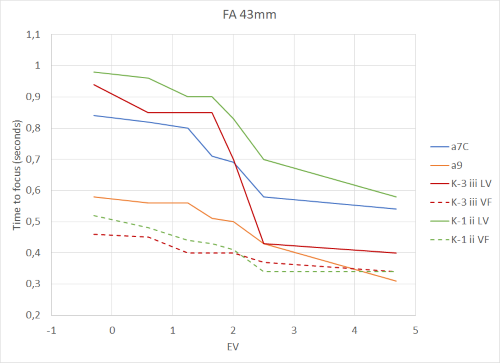
We can draw many observations from these results. First, the very best AF speed is obtained by using a Pentax DSLR and phase focus. This is not surprising, since the FA 43mm Limited was launched at the end of the millennium, when PDAF was the only option existing. Second, the G Driver 2 (on the a9) results are almost identical to Pentax’s PDAF. That’s a big achievement for the LA-KE1. Third, G Driver 1 with the a7C does better than the K-1 II’s contrast AF. Last, the K-3 III (the most recent Pentax DSLR on the market) does better than the K-1 II using live view. The K-1 II, K-3 III and a7C improve visibly above 2 EV.
Monster Adapter’s claim that G Driver 2 is “better than Pentax AF” appears true, but only when comparing with CDAF.
In general, results are very good, with perfectly usable AF speeds with this older screw-drive lens.
Results With The FA 77mm Limited
The FA 77mm Limited is a few years younger than the 43mm and uses the same screw-drive AF motor.
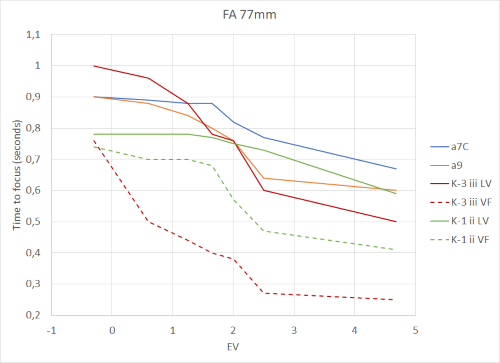
Results here are different. Using PDAF (with a DSLR’s viewfinder) shows better results. We need to keep in mind that in absolute terms, 0.1 second is a small number. G Driver 2 still does better than version 1, but differences here are minimal. The four cameras perform similarly when using live view. In general, AF speeds are good without being blazing fast with this lens.
Results With The D FA 28-105mm
The D FA 28-105mm F3.5-F5.6 is a consumer zoom, with a compact size, rugged body, useful everyday focal range and weather resistance. Its size, including the adapter, is similar in length (and narrower in width) than the Tamron 28-75mm F2.8. For hiking, travel, or any application with good light, the lens is a flexible option.
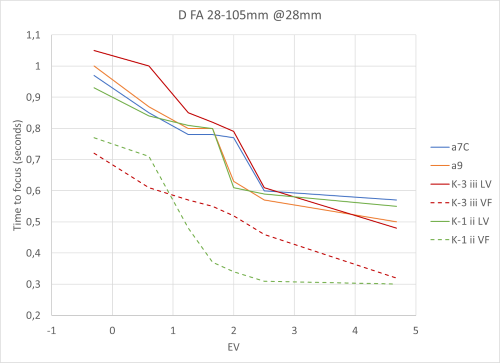
With this lens, best results are obtained with PDAF on the two Pentax cameras. All other test results are similar regardless of the camera. In absolute terms, the lens focuses fast and decisively.
Results With The DA* 60-250mm
The DA* 60-250mm F4 is a lens beloved for its superb image quality, rendering, and range. It is nominally an APS-C lens, but a simple modification of its internal baffle allows it to be used on full frame without trouble. Because of this, it sits in a rather unique position on the whole photography landscape. Its AF speed has never been remarkable, however. It is one of the few lenses whose SDM motor has a higher-than usual failure rate.
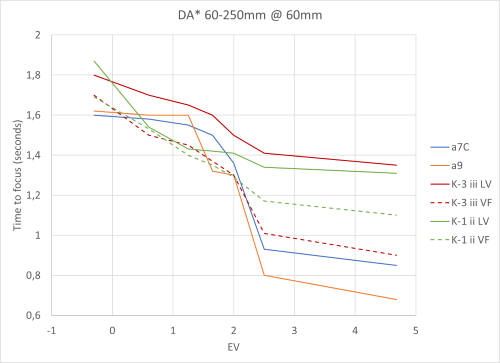
The slower AF of this lens is immediately apparent. It is interesting to note that the two Sony cameras deliver the best results, despite the lack of support for G Driver with SDM lenses. Using the viewfinder on the new K-3 III is almost as good. Using CDAF on Pentax cameras lags behind.
Results with the F 1.7X TC And FA 43mm Limited
We described the TC in the Compatibility section above. This converter has no AF coupling with the lens and performs AF by itself, using a form of screw-drive. It does control the aperture of the lens and reports accurate data to EXIF. Its AF range is somewhat limited; the lens must be roughly focused beforehand, bringing it to the correct ballpark. There is no focus ring on the TC.
Given the low light conditions and the light loss from the TC, viewfinder AF was too erratic to be measured accurately. Because of this, only live view AF speeds were measured with the two Pentax bodies.

Results in very low light were included to be consistent with our previous graphs, but their spread is in line with our comments above: in low light, the TC struggles to lock focus quickly and accurately. This isn’t a problem: a teleconverter isn’t intended to be used at close range in very low light. Users shouldn’t be alarmed by this.
In better conditions, the G Driver 2 on the a9 provides, by a fair margin, the best AF speeds. This is impressive. The other lenses are close: the a7C and K-3 III are almost identical, and the K-1 II not too far behind. Focus speeds are never high, which is to be expected for an AF adapter-TC dating from the mid-80s. Note that small corrections and AF adjustments are much, much faster than what we report. Also, we limit our tests to low light conditions; the TC will perform better in bright sunlight (16 EV).
Summary For AF-S
The first conclusion is that the LA-KE1 adapter DOES provide fast and reliable AF. In general, it can compare to what a Pentax DSLR body can provide. That’s no small feat in itself.
The second conclusion is that G Driver 2 does perform better than G Driver 1, and better than Pentax’s CDAF. That’s also an impressive achievement. Users of a Sony camera supporting G Driver 2 are in luck; others will still get pretty good results.
AF-C
Methodology
Continuous AF, or AF tracking, can be difficult to evaluate quantitatively. To do so requires repeatable test conditions, target speeds, illumination and direction. Many AF-C tests have been criticized for their perceived lack of reproducibility.
We tested the AF-C performances of the adapter using cars coming towards the photographer on a highway. Even if car-to-car speeds vary, they will be for the most part within ±10% from one another, ensuring repeatability when a large number of images are captured. We set the camera to high-speed burst mode (the Hi+ option blanks the screen and is not advisable for such a test) using the Expand Center point AF. Focus was locked on a distant target and the AF point was kept on the car’s front bumper as the camera captured pictures in burst mode. We then performed a statistical comparison of the results. In each case, we took a large number of test pictures and ranked the results on a three-levels scale:
- Good: the image appears sharp
- Partial: the image is slightly blurred but features are easily visible; image is usable
- Poor: the image is significantly blurred and would be considered unusable
This scale is of course subjective. To preserve objectivity as much as possible, the same person ranked the images without knowing which camera took each picture. All pictures were captured in good light with even illumination, using the FA 77mm Limited, D FA 28-105mm and the DA* 60-250mm (using both SDM and screw-drive). We used the Sony a7C. All lenses were set at F5.6.
The two images below illustrate our definition of a “Good” and “Fair” result.

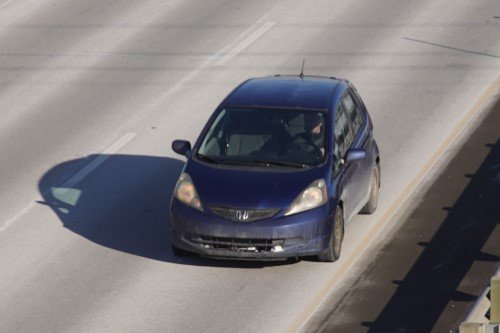
The following charts summarize the results.
Results With The FA 77mm Limited

In general, the FA 77mm performed as expected. There were a few occurrences where the lens hunted and was unable to quickly identify a subject. Pre-focus (having the focus set in the rough ballpark where the subject would be) completely removed this issue. As with any situation, automated camera modes aren’t a complete replacement for good technique.
Tracking once focus was locked turned out quite good. The lens never lost its subject once acquired. Being used to silent E-mount AF, it is surprising (but not disturbing) to actually hear the lens adjust focus incrementally. The success rate, just below 90%, is close to what an E-mount lens typically delivers. “Fair” results are still usable, and occurred when the target got close to the camera. This is where a typical Sony or Tamron lens fails also.
Results With The D FA 28-105mm
The lens was set at 105mm for the test.

As with AF-S, the system does better with a DC-motor lens. About 93% of images were “Goog”. The lens almost never hunted, never failed to find a subject, and tracked with decisiveness. Using this lens is similar to using a typical E-mount lens.
Results with the DA* 60-250mm
The lens was set at 135mm. We tested both SDM and screw-drive AF, thanks to the unique option offered by the LA-KE1 adapter (Pentax users do not have this option, except if they hack their lens).
Note that, with the adapter set to mode 1 (forced screw-drive), most lenses will still use their SDM, DC or PLM motor. Only five lenses with both screw-drive and SDM will revert to screw-drive. Those lenses were made this way to ease the transition towards the new AF engine.
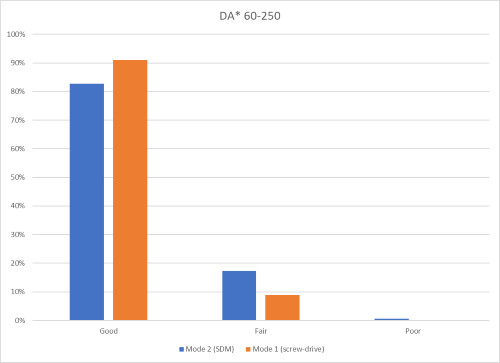
Again, the DA* 60-250mm has never been known for its blazing fast AF. Using SDM, the lens did adequately, with 82% of “Good” images and 15% “Fair”. One image turned out poor. These results are a bit underwhelming, but still, four images out of five turned out good. As with the FA 77mm, there were some times where the lens had trouble locking on a subject.
Forcing screw-drive, the system did better. We observed no hunting or difficulties finding subjects, and the hit rate is close to that of the D FA 28-105mm. Screw-drive is noisier than SDM, but that is the only drawback to this option.
Summary For AF-C
The LA-KE1 adapter allows tracking with good accuracy, even though results vary for each lens. DC AF performed better, as expected. Using G Driver (version 1 here) yielded better results than SDM with our test lens.
In conclusion, it is perfectly possible to use AF-C with the adapter.
Autofocus Accuracy
We did not observe occurrences of inaccuracies with the adapter. We could trust focus confirmation and the focus point was where we expected it.
The images below show examples using macro scenes, using the a7C and SMC D FA 100mm macro WR lens. Images were shot handheld.






Eye AF
We tested the system for eye AF accuracy. On the E-mount, Eye AF is dependent both on the camera and the lens, while on Pentax lens there is no such ability linked to the lens, and the cameras supporting it do the heavy lifting themselves. The LA-KE1 adapter has the ability to work with the Sony camera and Pentax lens to allow Eye AF.
In our experience, Eye AF worked just as well as with a traditional E-mount lens. From a user’s perspective, there is no visible difference when using the adapter. The images below illustrate some examples. They were shot with the a7C and the SMC FA 77mm Limited at F2 and F2.8.




Unexpected Behaviors
In our experience, utilizing the LA-KE1 adapter happens without hiccups and troubles (we are testing with firmware v03). It works as it should. There are still some tiny events, which can occur from time to time, and are worth mentioning along with their workarounds.
EXIF Errors
We observed two types of errors when looking at EXIF data in Lightroom and elsewhere.
The first concerns lenses with variable apertures, such as the D FA 28-105mm. When shooting at longer focal lengths and the fastest aperture (for instance, 105mm and F5.6), the system reports the fastest aperture of the lens, F3.5 in the example below:

The second quirk concerns the actual reporting of aperture. With the DA* 60-250mm, it is reported as being a lens with max aperture “F4.1”:

Other lenses, such as the FA 43mm F1.9 Limited, have unusual apertures, unknown to Sony systems. Their maximum aperture is reported as F2.
Resetting The Adapter
Turning off the camera does not reset the adapter. This can trick the camera sometimes into thinking a different lens is mounted (we did not observe this, but some users on the web did report erratic behaviors with earlier firmware versions). To reset the adapter, it only needs to be disconnected, even partially, from the camera. This should be done when changing lenses to avoid problems.
Battery Drain
With prior versions of the firmware, some users reported (slight) battery drain even with the camera turned off. We were not able to observe this with firmware v03. Still, good practice suggests to reset the adapter after having turned off the camera.
Conclusion

The LA-KE1 adapter sits in a unique niche in the photographic market. It has no true equivalent in its ability to adapt Pentax lenses on Sony cameras while retaining AF, auto exposure, EXIF recording.
The adapter was created by a small Chinese company. Despite not coming from a big brand, it is a solid product with continuous support and development.
The adapter is physically impressive. Sleek, elegant, solid with its metal body. Its only external control, the AF/MF switch, is logically located and operates well. We would have liked to see the adapter being weather resistant to match Sony cameras and Pentax lenses.
The LA-KE1 is easy to mount and use. This is its biggest strength: with any of the 64 supported lenses, it operates as would a native lens, in a way that’s mostly transparent to the user. The camera will focus, track moving subjects, detect eyes, control exposure and record all relevant information in the EXIF companion file. Everything is automatic as with an E-mount lens.
Autofocus performances are as good as can be expected, possibly even better. Indeed, many users will probably assume sluggish and inaccurate AF, while in fact the LA-KE1 delivers results on par with a Pentax DSLR, and sometimes better. Results will vary with individual lenses, of course. Pentax lenses are better than their reputation for AF, but do tend to lag a bit when compared with E-mount lenses. The good news is that the adapter does not make them slower. Part of the perception towards Pentax AF is that so many legacy lenses are still supported, and those lenses cannot compare with a lens released only last year. Pentax lenses with DC (or PLM, even faster) are mostly comparable with Sony lenses.
The large number of supported lenses means most users will find what they are looking for. There is a bias towards primes, but that’s where the most interesting Pentax lenses are found.
Many users can benefit from this adapter. From current Pentax users interested in running a dual system, to current Sony users curious about Pentax glass, and to enthusiasts who like to experiment, anyone with an interest in this adapter can look at the LA-KE1 with confidence, knowing it is a quality product. The price tag isn’t cheap, but nor is it prohibitive: it costs less than most lenses.
For all the qualities we mentioned in our review, we believe this adapter is worthy of consideration.
Pros
- Very good build quality
- Useful AF/MF switch
- Reliable and accurate metering
- Autofocus works well, both AF-S and AF-C
- AF speed is generally comparable with Pentax bodies
- G Driver 2 offers increased speeds with screw-drive
- SDM/screw-drive switch can revive lenses with defective SDM motors
- 64 lenses currently supported
- Constant firmware improvements
Cons
- No weather resistance
- Some features, mainly AF driver, depend on camera body
- Some reported quirks in use
- No support for movie mode
Check Price & Reviews: Monster Adapter LA-KE1
At: B&H Photo | Amazon
Before You Go
Do you own the Monster Adapter LA-KE1, other adapters from this manufacturer, or are you curious about it? Post your opinion or ask your questions in the comments below!


Thank you, what a wonderful review. I currently shoot with a K1 II, and I find the AF very lacking, especially in low light. My HD D FA * lenses often really hunt. Also, there is of course no eye autofocus. I have used a K3 III and was impressed with the autofocus for the most part. The speed was very good.
My question to you is, on a body like the A7 IV or A7R V, will I get that great Sony accuracy and tracking? I’m especially interested in eye tracking. My K1 II leaves me with soft eyes and sharp noses way too often. I would be VERY happy with the speed of a K3 III and the accurate eye AF of a Sony. Will this adapter give me that? That would make this a slam dunk for me in adding a Sony body to my gear setup as a second body for events and weddings.
Did anybody made a wildlife real test?
I’m pentaxian since 2012, and I own Pentax 300mm f4 (among others) but switched to Sony a7 IV due to Autofocus issues on Pentax for wildlife. On Sony I use the 200-600 G lens, but is not a GM, and I think the Pentax 300mm f4 will provide better results (with focal length limitation, of course, but I’ll win the coating and aperture), and all this is useless if autofocus reliability and precision is not improved in the Sony A7 iV + Pentax DA 300mm F4 SDM compared with Pentax K3 II + same lens . (I do have also 1.4 TC from Pentax).
Any feedback is welcomed.
Thank you!
Hello Adrian!
Focus precision as you put it, or accuracy in general terms, has historically been excellent with Pentax. Tracking speed is where the company’s camera lag behind the competition. The new K-3 III improves significantly but is still not on par with Sony tracking.
I have not been able to test specifically the DA* 300mm F4 with the adapter. The 300 is an SDM lens but by all accounts better than the 60-250 as far as AF speed is concerned. I would guess that its abilities put it closer to the 28-105mm which got tested. I believe you will get good results, as the review shows tracking with the Monster adapter has been quite dependable.
Hello,
Just want to let you know that I took a chance with the addapter and having A7 iv +pentax 300 f4….i have to say, the combo is a monster. Defently I can’t compare the focus speed to the one of an e-mount lens, but is much improved than what I’m getting on my k3-ii and result is impresive: excelent bokeh, amazing sharpnes, better low light option, easy to carry.
Wish you all the best!
Without your review I wasn’t willing to part with the additional cost for the Monster adapter so I’m using a dumb adapter for my Pentax lenses.
I use the SMC FA 50mm F1.4 and an SMC FA 80-200 zoom, both with aperture rings. The AF performance of these early lenses was never very fast, so manual focus is just fine. They suffer without a split field for focus assist, but the A7iv has this covered, using 5x magnification.
My other K-mounts are sigma DC zooms without an aperture ring, and limited to crop mode. I have used a bit of sticky tape to hold the aperture wide open. But these, I’ll just mount on the Pentax body. to get AF out of them.
There is some good pentax glass which is not expensive, and some iconic lenses for nostalgia, such as the 40mm pancake lense designer lens.
Hi Gary! Agreed a lot of excellent Pentax glass is available, and thanks to the Monster Adapter it gains automatic controls on Sony cameras. Indeed all the Limited lenses have strong appeal for any system.
Thanks Bernard! Cool to think my F17-28fe and DA70 Limited could autofocus again. It sounds like the Sigma zooms will have to await word on compatibility, and they are old enough that testing may never happen.
Most of my other PK lenses are elder primes that would not be AF capable but images sure are nice. The miniscule DA70, M85/2 and M135/3.5 are great matches with my α7ii body.
Hi Jim!
Agreed with you, many of these older primes are compact and the large EVFs on mirrorless cameras, coupled with focus peaking, make them easy to use. Still, benefiting from AF is welcome 🙂 I’m sure you’ll have lots of fun using the two AF lenses you mention with your Sony camera!